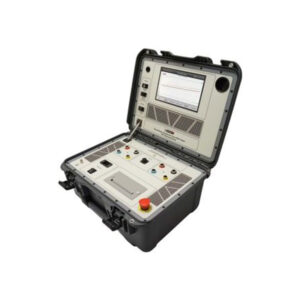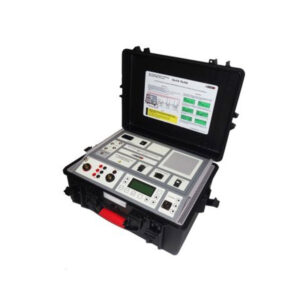Description
The CAT Standard series circuit breaker analyzers & timers are stand-alone or a PC-controlled digital instruments for circuit breakers condition assessments. The timing channels record closing and opening of the arcing, resistor, and auxiliary contacts. CAT Standard series records graphs of both, trip and close coil currents and displacements of the HV and MV circuit breaker moving parts. The main contact channels can also measure the resistance value of the pre-insertion resistors (if present in the circuit breaker). Test results can be downloaded to a USB memory stick or saved to internal memory. The CAT Standard series internal memory can store up to 500 test results (numerical and graphical data). Test results can also be printed on the 80 mm (3.15 inch) thermal printer (optional accessory) in tabular and graphical form.
CAT Standard series provides an easy selection of different operational modes:
- – Trip (O)
– Close (C)
– Reclose (O-0,3s-C)
– Tripfree (CO)
– O-0,3s-CO
– Trip-Close (O-C)
– Close-Trip (C-O)
– Trip-Close-Trip (O-C-O)
Multiple operations, such as Trip-Close and Trip-Close-Trip, can be initiated by using a predefined delay time or by sensing a breaker’s contact position.
The circuit breaker operation can be initiated in different ways (for instance from a control room, by a local switch or externally by a testing device) depending on the testing condition. Several time measurement triggers are available to record measurements in various testing conditions:
- – external trigger
– analog channels
– auxiliary channels
– coil control channel
The auxiliary inputs are used to monitor dry and wet auxiliary contacts. The external trigger input can be used as the additional auxiliary input.
The two coil control analog channels can measure and record the coil currents simultaneously (TRIP and CLOSE), up to 35 A AC/DC.
The two additional analog channels have four selectable voltage ranges available (±0,5 V, ±2,5 V, ±60 V and ±300 V AC/DC). They can be used to monitor:
- – Circuit-breaker substation battery voltage,
– Motor voltage and current,
– Other types of analog signals that may be relevant.
The transducer channel is intended for measuring the displacement of the circuit breaker moving parts, contact wipe, over-travel, rebound, damping time, and average velocity. Either an analog or a digital transducer can be connected to this universal channel






